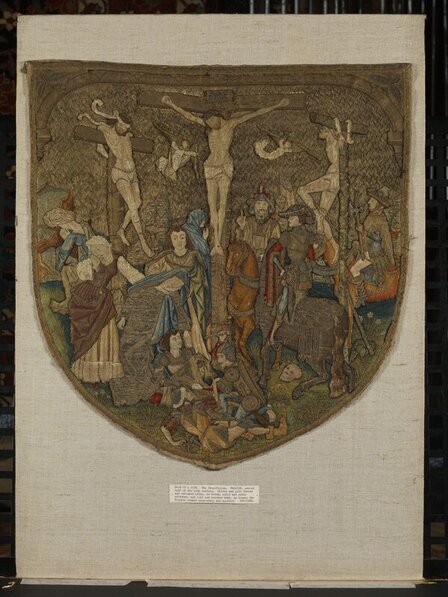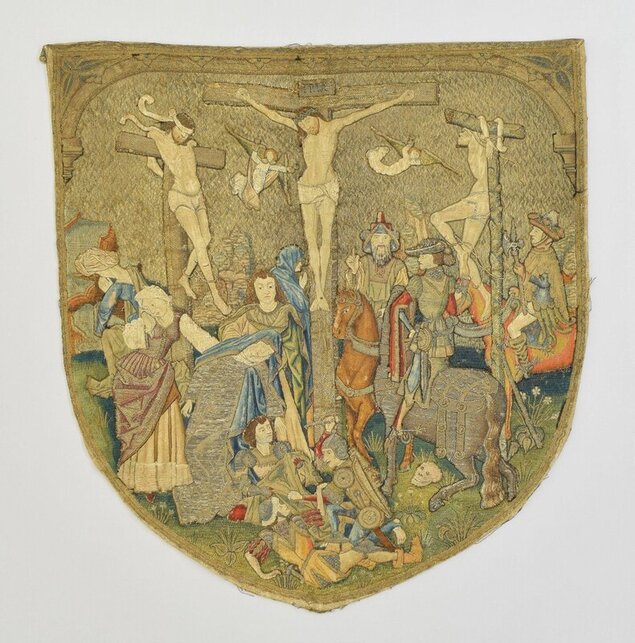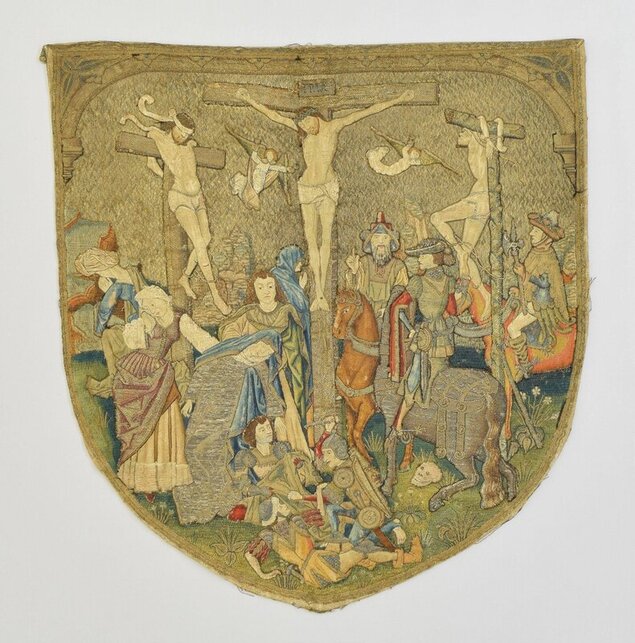|
In November 2019, I visited the Clothworkers' Centre in London to study several pieces of embroidery kept in the V&A collection. One of these pieces was a cope hood from Flanders made in the second half of the 15th century (Accession Nr. 990-1888). The piece was bought in 1888 by the museum and lacks any further provenance. Lone cope hoods are pretty common in museum collections. This part of a cope is already relatively loose and could easily be separated before being sold on the art market. Pieces without provenance, like this lone cope hood, always make me a bit sad. So much information was lost. Nevertheless, it is a very fine piece of late-medieval goldwork embroidery. Let's explore! The cope hood measures 53.3 x 51.4 cm and the embroidery fabric is a finely woven linen. Originally, the hood would have been trimmed with some sort of decorative fringe. It likely also had a tassel of some sort dangling from its lowest point. In those areas where the embroidery has fallen out (lower part of the undergarment of the lady with the red dress on the left), a finely shaded underdrawing is visible. Although I am generally not very keen on crucifixion scenes, this one I quite 'like'. There is so much going on. There is so much movement. And there are so many fine details. This is late-medieval art at its best! The design is very high quality and was likely made by a famous artist. Maybe a painter or someone who designed church windows (we know from written sources that they provided embroiderers with designs too). It is highly unlikely that the design stems from an embroiderer who happened to be a fine draftsman too. So, what do we see? And how was it embroidered? We, the viewers, are looking towards Golgotha from under an arch (probably the city gate of Jerusalem as Golgotha was 'outside the city gate' according to Hebrews 13:12). The arch is a far more intricate piece of embroidery than what it looks at first glance. It is partly embroidered as a continuation of the diaper pattern background (capitals on the sides), whilst the gold threads of the rounded arch neatly cover the turns of that same diaper pattern. The silver trefoils in the corners are also very intricately embroidered. There's twist and something that looks like a chain stitch executed with passing thread. On the arch itself, halved quatrefoils are embroidered at regular intervals. Their 'petals' are actually part of the arch. By couching 'petal' outlines onto the arch, the quatrefoils emerge. The diaper pattern used for the background is of the common open basketweave type. The couching stitches were once bright red; the most common colour used. Also part of the background are beautifully stitched rocks. They are embroidered directly onto the background linen. The rocks are made with Burden stitch and use a variety of green and brown silks. On top of this base layer, additional details are stitched with silks and gold thread. The rest of the background consists of a meadow stitched with several shades of green in Burden stitch. At the top, the Burden stitch is worked very densely so that the foundation gold thread can hardly be seen. Towards the bottom, we see the gold thread clearly. On top of the grassy base layer, grasses and several species of plants are stitched with silk and gold. None of the plant shapes is repeated. The flowering plants have different flowers. Maybe the plant lovers in my audience can identify them? Also present in the meadow is a rather funny-looking skull. It has lost most of its embroidery but is still readily identifiable. The skull is a hint to show that we are at Golgotha. According to the bible, Golgotha means 'place of the skull'. And what's with all the people on this piece? They actually tell different parts of the gospels in one very lively scene. Firstly, there are the three crucified people: Jesus in the middle flanked by two criminals. See the body language of those two criminals? The one on the left looks submissive. The one on the right not so much. He even sticks out his tongue. The story of the good thief and the unrepentant thief is told in the gospel of Luke. Interestingly, the crosses of Jesus and the good thief are identical (made of timber), whereas the cross of the unrepentant thief is made of green wood. Has anyone seen this before in embroidery or a painting? Oh, and then there are the two angels with their chalices catching Jesus' blood for the Eucharist.
Next up, are the people on the left. They are on the good side with the good thief. We see four women and a man. The woman on the left with a fancy laced red dress is Mary Magdalene. The woman to her right is Mary mother of Jesus. She is fainting and being caught by Saint John who stands behind her. The two other women in the back are sometimes known as Salome and Mary the wife of Clopas. The bible is vague about these other women. Is this why the designer decided to show them only from the back? On the 'wrong' side are three horsemen. Two are clearly soldiers as they wear weapons. But who is the guy with the strange hat? He points up. What does he want? Is he pointing at Jesus? Is he the centurion who according to the gospel of Mark identifies Jesus as the son of God? Or is he a Jewish priest (as the V&A website suggests)? Any ideas? The last group of figures sits at the bottom of the cross. Three soldiers are dividing Jesus' garment to each have a piece. This is also a well-known story from the gospels. Whoever drew the design for this cope hood was very well acquainted with the biblical stories. Far more so than most people are today. How are all these different figures stitched? None of them are stitched directly onto the background linen. Instead, single figures or a group of figures are stitched on a separate piece of linen and then appliqued onto the background. This creates a little bit of depth in the embroidery. Can you see some of the crude white tacking stitches along the edges of parts of some of these figures? These are later repairs. It never ceases to amaze me that people repaired these very high-class embroideries with such crude stitching in later times! Have a good look at the embroidery of the figures. You will see beautiful or nue in the clothing of some of the figures, on the crosses and on the horse. There is also beautifully shaded medieval long and short stitch (it is more a counted thread technique than our modern version of long and short). The use of both gold and silver thread further enhances the design. The quality of the embroidery matches the quality of the design. This would once have been a very expensive piece of embroidery. It was probably commissioned by an important church or important church leader. Think cathedral or bishop. If we only knew for which church it was originally intended. Or who designed or stitched it!
4 Comments
Irene Kennedy
11/10/2023 17:29:47
That was very interesting. It amazes me how much detail was stitched into this cope. It definitely is very sad that the history of this cope is lost. So many stories depicted in one piece of embroidery. I am also grateful that these pieces have been able to survive all these years and that we are able to enjoy and extrapolate the stories in them.
Reply
Needle Lady of Helvetia
12/10/2023 07:19:39
It looks like that Maria Magdalena's dress was stitched with a different stitch then Marie's and the other two ladies' dress. Or is this an illusion as Marie's dress looks like it is not in as good shape as Maria Magdalena's?
Reply
12/10/2023 08:33:08
The dresses of Mary mother of Jesus and Mary Magdalene are both stitched in or nue. The embroiderer used gold thread as a base for Mary Magdalene's dress and silver thread for Mary mother of Jesus. The dresses of the two other Marys are not stitched in or nue but in long and short with silk only.
Reply
Your comment will be posted after it is approved.
Leave a Reply. |
Want to keep up with my embroidery adventures? Sign up for my weekly Newsletter to get notified of new blogs, courses and workshops!
Liked my blog? Please consider making a donation or becoming a Patron so that I can keep up the good work and my blog ad-free!
Categories
All
Archives
July 2024
|
Contact: info(at)jessicagrimm.com
Copyright Dr Jessica M. Grimm - Mandlweg 3, 82488 Ettal, Deutschland - +49(0)8822 2782219 (Monday, Tuesday, Friday & Saturday 9.00-17.00 CET)
Impressum - Legal Notice - Datenschutzerklärung - Privacy Policy - Webshop ABG - Widerrufsrecht - Disclaimer
Copyright Dr Jessica M. Grimm - Mandlweg 3, 82488 Ettal, Deutschland - +49(0)8822 2782219 (Monday, Tuesday, Friday & Saturday 9.00-17.00 CET)
Impressum - Legal Notice - Datenschutzerklärung - Privacy Policy - Webshop ABG - Widerrufsrecht - Disclaimer









 RSS Feed
RSS Feed